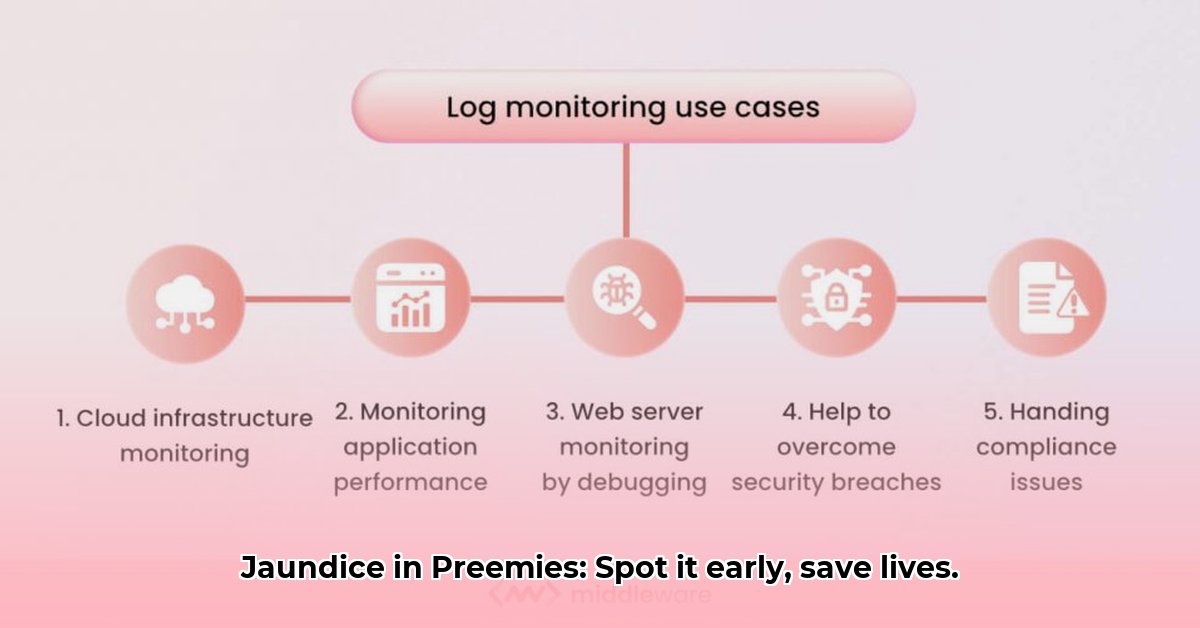Jaundice in preterm infants presents unique challenges. This guide offers a comprehensive overview of jaundice in this vulnerable population, covering causes, detection, management, and the crucial role of parents and healthcare providers.
Why Preterm Infants Are More Susceptible to Jaundice
Jaundice, marked by a yellowing of the skin and eyes, is common in newborns, but preterm infants (born before 37 weeks gestation) face a higher risk. This is because their bodies are less equipped to handle bilirubin, a yellow pigment produced during the normal breakdown of red blood cells. Several factors contribute to this increased vulnerability:
- Immature Liver: A preterm infant’s liver is still developing, hindering its ability to efficiently process and eliminate bilirubin.
- Increased Red Blood Cell Turnover: Preterm infants often experience a faster rate of red blood cell breakdown, leading to higher bilirubin production.
- Delayed Gut Motility: A slower digestive system can lead to increased reabsorption of bilirubin back into the bloodstream.
The Importance of Early Detection and Monitoring
Early detection and appropriate management are crucial to preventing serious complications, including kernicterus, a rare but devastating form of brain damage caused by high levels of bilirubin.
Recognizing Jaundice: Signs and Symptoms
Parents and caregivers should be vigilant for the following signs of jaundice in preterm infants:
- Yellowing of the Skin and Eyes: This is the most obvious sign, typically starting on the face and progressing down the body.
- Lethargy: The baby may be unusually sleepy or difficult to wake.
- Poor Feeding: A decreased interest in feeding or difficulty latching on.
- Dark Urine: Urine may appear darker than normal.
- Pale Stool: Stool may be lighter in color than normal.
If you observe any of these signs, promptly consult your healthcare provider.
Diagnostic Methods: Assessing Bilirubin Levels
Several methods are used to assess bilirubin levels in preterm infants:
- Visual Assessment: While a first step, visual assessment alone is unreliable for accurate measurement.
- Transcutaneous Bilirubin (TcB) Measurement: This non-invasive method uses a handheld device to estimate bilirubin levels through the skin. TcB is useful for screening, but less accurate than blood tests, especially in preterm infants, and can be affected by skin tone and thickness.
- Total Serum Bilirubin (TSB) Measurement: This is the gold standard for accurate bilirubin measurement, requiring a small blood sample.
The frequency of bilirubin testing is determined by the infant’s gestational age, risk factors, and TcB results.
Risk Factors for Jaundice in Preterm Infants
Besides prematurity, other factors can increase the risk of jaundice:
- Low Birth Weight: Infants with lower birth weights often have less mature liver function.
- Blood Group Incompatibility (Rh or ABO): If the mother and baby have incompatible blood types, the mother’s antibodies can attack the baby’s red blood cells, leading to increased bilirubin production.
- Glucose-6-Phosphate Dehydrogenase (G6PD) Deficiency: This genetic condition affects red blood cell metabolism, increasing the risk of jaundice.
- Cephalohematoma or Bruising: These conditions can result in increased red blood cell breakdown and bilirubin production.
- Breastfeeding: While breastfeeding is beneficial, it can sometimes contribute to jaundice, particularly if the infant is not feeding effectively.
Treatment Options for Jaundice in Preterm Infants
Treatment decisions are based on the infant’s bilirubin levels, gestational age, and overall health. Common treatment options include:
- Phototherapy: This involves exposing the baby to special blue lights that help convert bilirubin into a form that can be easily excreted in the urine and stool. Phototherapy is typically administered in a hospital setting, but home phototherapy may be an option in some cases.
- Exchange Transfusion: In rare cases of severe hyperbilirubinemia, an exchange transfusion may be necessary. This involves removing small amounts of the baby’s blood and replacing it with donor blood, rapidly reducing bilirubin levels.
The Role of Breastfeeding in Jaundice Management
Breastfeeding is generally encouraged, even in infants with jaundice. Frequent breastfeeding (8-12 times per day) helps promote bilirubin excretion through stool. However, in some cases, temporary supplementation with formula may be recommended to ensure adequate hydration and caloric intake. Consult with your healthcare provider for personalized guidance.
Long-Term Outcomes and Follow-Up
Most infants with jaundice recover fully with appropriate treatment. However, close follow-up is essential to monitor bilirubin levels and ensure that any potential complications are promptly addressed.
Parents as Partners: Monitoring and Communication
Parents play a vital role in monitoring their preterm infant for jaundice and communicating any concerns to their healthcare team. Key steps include:
- Observing the baby for signs of jaundice.
- Following the healthcare provider’s recommendations for bilirubin testing.
- Ensuring adequate feeding and hydration.
- Reporting any changes in the baby’s condition to the healthcare provider.
Open communication between parents and healthcare providers is essential for ensuring the best possible outcome for preterm infants with jaundice.
Accurate Interpretation of TcB Readings in Preterm Infants
Transcutaneous bilirubin (TcB) measurement offers a non-invasive way to screen for jaundice, but accurate interpretation is vital, especially in preterm infants.
Understanding TcB Limitations
TcB measures bilirubin levels in the skin using reflected light. It’s rapid and painless, avoiding repeated blood draws. However, TcB isn’t a perfect substitute for total serum bilirubin (TSB), derived from a blood sample. Several factors can affect TcB accuracy:
- Gestational Age: TcB accuracy varies with gestational age, being less reliable in very preterm infants.
- Skin Pigmentation: Melanin can affect light absorption, influencing TcB readings.
- Skin Thickness & Hydration: Skin thickness and hydration levels impact light penetration, affecting TcB accuracy.
- Phototherapy: TcB is unreliable in areas of the skin exposed to phototherapy.
TcB readings can overestimate actual TSB levels, particularly in young, small preterm infants.
A Structured Approach to Accurate TcB Interpretation
Healthcare professionals should use a structured approach:
- Proper Technique: Use a calibrated device on clean, dry skin, avoiding bruised or lesioned areas. Follow the manufacturer’s instructions precisely.
- Gestational Age Adjustment: Interpret readings using gestational age-specific nomograms or guidelines. These account for skin thickness and other factors.
- TSB Comparison (if available): Compare the TcB to an existing TSB result to assess overestimation, creating a baseline for future monitoring.
- Clinical Evaluation: Consider other factors like feeding status, weight gain, and alertness alongside the TcB level.
- Protocol Adherence: Follow institutional guidelines for managing jaundice in preterm infants, which define intervention thresholds based on TcB or TSB, gestational age, and clinical presentation.
TcB Advantages and Disadvantages
| Advantage | Disadvantage |
|---|---|
| Non-invasive, reduces infant discomfort | Accuracy varies with gestational age and skin type |
| Rapid results, enables timely intervention | Readings can overestimate bilirubin levels |
| Cost-effective, lowers healthcare costs | Potential for false-positive/negative results |
| Reduces infection risk | Requires skilled interpretation and ongoing training |
Key Takeaways
- TcB is a valuable screening tool, not a TSB replacement.
- Gestational age significantly affects TcB accuracy; adjust interpretation accordingly.
- Consider the clinical picture, not just the TcB value.
- Adhere to established protocols for safe management.
- Regular device calibration and staff training are critical.
Managing Breastfeeding-Associated Hyperbilirubinemia in Preterm Infants
Breastfeeding offers many benefits for preterm infants, but it can also contribute to hyperbilirubinemia. Managing this requires a balanced approach:
The Connection Between Breastfeeding and Bilirubin
Jaundice, characterized by elevated bilirubin, is common in newborns. Preterm infants are especially vulnerable, and breastfeeding can sometimes exacerbate it. Consider the following points:
- Early detection of jaundice is critical.
- Managing breastfeeding-associated hyperbilirubinemia requires careful monitoring and individualized strategies.
- Distinguishing between inadequate milk intake and true breast milk jaundice is vital.
- Treatment decisions depend on bilirubin levels, gestational age, and clinical status.
- Close collaboration between healthcare providers and parents is essential.
- Prompt intervention can prevent serious complications.
It’s essential to understand the different types of jaundice that can occur in breastfed infants:
- Breastfeeding Jaundice (Suboptimal Intake Jaundice): This occurs in the first week of life and is typically caused by inadequate milk intake, leading to dehydration and decreased bilirubin excretion.
- Breast Milk Jaundice: This occurs later, typically after the first week, and can persist for several weeks or months. It’s thought to be caused by factors in breast milk that interfere with bilirubin metabolism.
Strategies for Management
Managing breastfeeding-associated hyperbilirubinemia requires a personalized approach:
- Optimize Breastfeeding: Ensure frequent breastfeeding (8-12 times per day) and proper latch.
- Assess Milk Supply: Evaluate the mother’s milk supply and address any issues with lactation.
- Monitor Weight Gain: Track the infant’s weight
- Wind Turbine Generator Kit For Home: Is One Right For You? - November 2, 2025
- Wind Turbine Fire: Questions About Safety Spark Debate - October 31, 2025
- Vertical Axis Wind Turbine Design: Improving Efficiency and Overcoming Limits - October 29, 2025
















